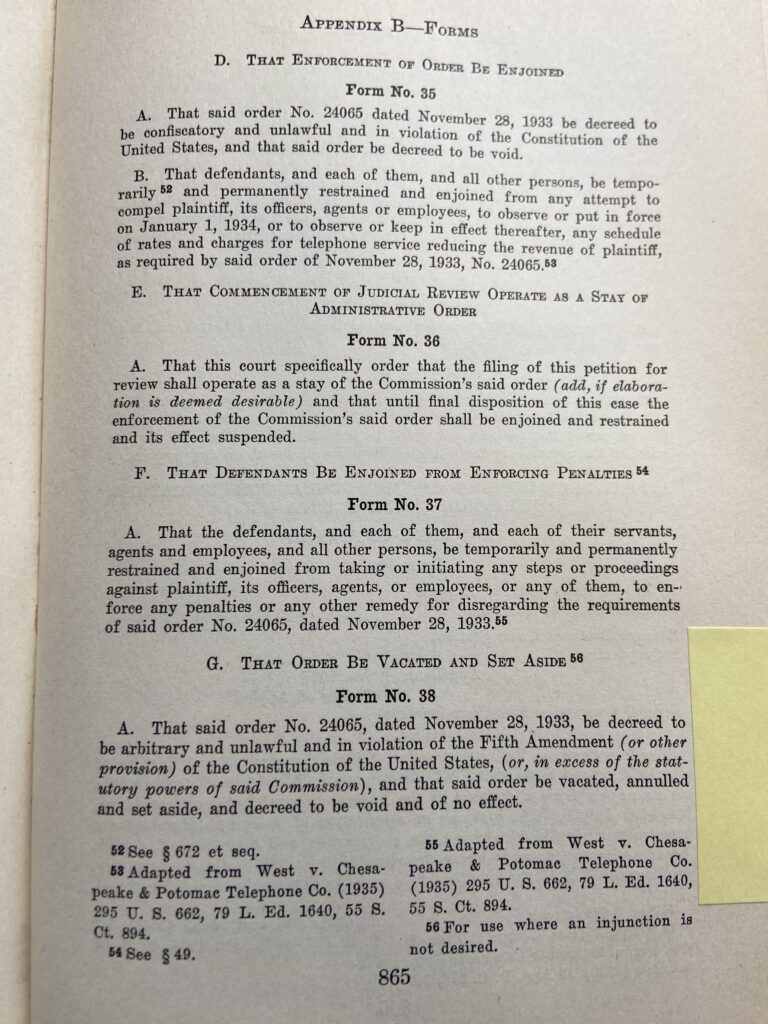Pre-APA Vacatur: One Data Point
In the recent and ongoing debate over administrative remedies, Professor John Harrison has argued that the drafters of the APA would not have been “familiar with a pre-enforcement remedy of vacatur distinct from injunctions and declaratory judgments.” I’m skeptical. Here I offer just one data point that has informed my skepticism.
This tidbit comes from a treatise on Federal Administrative Law, authored by F. Trowbridge vom Baur (a truly excellent name!) and published in 1942. Appendix B offers a number of “Forms” for attorneys to use, including a number of forms to follow when drafting the “Relief Sought” section of a complaint. One of these forms is as follows:
G. That Order Be Vacated and Set Aside
Form No. 38
A. That said order No. 24065, dated November 28, 1933, be decreed to be arbitrary and unlawful and in violation of the Fifth Amendment (or other provision) of the Constitution of the United States, (or, in excess of the statutory powers of said Commission), and that said order be vacated, annulled and set aside, and decreed to be void and of no effect.”
This is found on page 865, in the treatise’s second volume (a picture of this page is included at the end of this post). There is a footnote (numbered 56) that appears at the end of the title of this form, the entire text of which instructs: “For use where an injunction is not desired.”
Most of the forms in the book are inspired by reported cases. This form doesn’t say which case inspires it, but I suspect the case in question is the one that inspires at least two of the three other forms that appear on the same page. (I think this because the number (24065) and date (November 28, 1933) of the challenged order is the same in all three forms.) The case is West v. Chesapeake & Potomac Telephone Co. of Baltimore City, 295 U.S. 662 (1935).
The cited case appears to involve a pre-enforcement challenge to agency action. The district court decision in the case, 7 F. Supp. 214 (D. Md. 1934), explains that “[t]he Public Service Commission of Maryland by order dated November 28, 1933 required the the Chesapeake & Potomac Telephone Company of Baltimore City (a Maryland corporation hereinafter called the company) to file a new rate schedules [sic] effective on and after January 1, 1934, which would result ‘in a reduction of approximately $1,200,000 in the gross annual revenues of the said Company.‘” Id. at 217. The Company filed suit before the order became effective: “On December 13, 1933, the Telephone Company filed a bill in equity in this case to enjoin the enforcement of the Commission’s order on the ground that the reduction required was violative of the constitutional guarantee of due process of law contained in the Fourteenth Amendment to the Federal Constitution, and the new rates so ordered would be confiscatory of the plaintiff’s property.” Id.
The Company sought “a preliminary as well as a perpetual injunction.” Id. (Perhaps this is why the treatise doesn’t identify the case as the inspiration for the form requesting vacatur in lieu of injunction as relief?) A restraining order was put in place while a panel could be convened and a hearing held. In May 1934, the district court issued a “final injunction against the enforcement of the order of the Commission.” Id. at 238. The Supreme Court affirmed (albeit on different grounds than those relied upon by the district court), with the effect of “setting aside the order of the commission and leaving the old rates in force.” 295 U.S. at 680 (Stone, J., dissenting).
Here’s a picture of the relevant page of the treatise:




